Section 5.5: Short pulse high intensity laser machining
It is shown that the shortening of pulse length and the subsequent increase in beam intensity result in much thinner recast layers and heat affected zones (HAZ), less microcracking or delamination of materials, and much better geometry stability.
Machining or material removal by a laser beam involves the following basic steps: absorption of the laser radiation by the material, re-distribution of the absorbed energy within the target material, and material removal by evaporation and/or melt ejection. Therefore, key laser parameters that affect the process are: beam intensity, pulse width and energy, and wavelength. There are growing industrial needs for new processes that are faster and deliver better machining quality. The growing use of advanced materials that are hard to machine also presents additional challenges.
Take hole drilling as an example. The most widely used laser in industry is the flash-lamp pumped rod Nd:YAG laser operating in the free running mode, typically with 1 ms pulse length, 106 W/cm2 intensity, and 1064 nm wavelength. Some limitations of this type of lasers are: thick recast layers and heat affected zones (HAZ), poor hole-to-hole geometry stability, introduction of microcracks, charring, and delamination (for composites or coated structures). By using a high brightness Nd:YAG laser and an ultrafast Ti:sapphire laser, X.L.Chen (1999) tested metals, ceramics, and composites. The master-oscillator-power-amplifier (MOPA) Nd:YAG laser system has an average power of 100 W and about 1.2 diffraction-limited beam quality. It is Q-switched and/or modelocked. Hence pulse lengths are in the hundreds of picoseconds to hundreds of nanoseconds range, resulting in beam intensities of 108 - 109 W/cm2. It is shown that the shortening of pulse length and the subsequent increase in beam intensity result in much thinner recast layers and HAZ, less microcracking or delamination of materials, and much better geometry stability. Both the fundamental 1064 nm and the second harmonic wavelength of 532 nm are tested, showing substantial additional advantage for the shorter wavelength. The 100 fs Ti: sapphire laser produces even higher intensities in the 1015 W/cm2 range, resulting in even better machining quality.
The conventional, relatively long pulse experiments were performed using a Lumonics JK704 and Convergent Energy (formerly Coherent General) M34 Nd:YAG rod laser systems. These flash lamp pumped lasers operate in the 1 ms pulse regime, with a focused laser intensity of about 106 W/cm2. Average power was between 50 and 150 W at a pulse repetition rate of 5 to 20 Hz. A 15.24 cm focal length lens was used with a conventional gas assist nozzles employing shop air at 60 psi. Approximately 0.5 mm diameter holes were drilled in N5 (a Ni-based superalloy), NiAl intermetallic, and SiC ceramic matrix composite (CMC).
A flash lamp face-pumped slab laser (FPL) operating at free-running mode with a pulse repetition rate of 10 Hz. Processing tests at two pulse widths were studied: 9.4 ms and 0.65 ms, resulting in a focused laser intensities in the 105 to 106 W/cm2 range, when a 100 mm focal length lens is used to focus the beam at the surface of samples. Cutting and drilling of Al-30%SiC metal matrix composite (MMC) were performed.
As shown in Figure 1, this .Nd:YAG laser has much shorter pulses and also provides second harmonic wavelength of 532 nm. It consists of a cw-pumped Nd:YAG oscillator followed by a cw face-pumped, total internal reflection Nd:YAG slab for the amplifier gain medium10 (a MOPA configuration). The multipass amplifier preserves the TEMoo diffraction limited beam quality of the oscillator to over 100 W average power at 1064 nm. Up to 60 W of second harmonic generated (SHG) output at 532 nm wavelength is obtained by an LBO crystal. The output format is generated in the oscillator as either Q-switched or simultaneously Q-switched and modelocked. The Q-switched pulse rate and duration are 5 kHz and 300 ns, while in the Q-switched/model locked format, 520 ps pulses are spaced approximately 12 nanoseconds apart in the Q-switch pulse envelope. With a 250 mm focal length lens, the intensity at the focal position, where the workpiece is placed, can be as high as 108 W/cm2. A Ti: sapphire CPA (Chirped Pulse Amplification) laser system is used for the ultrafast laser machining tests. Either a 180 fs or a 8 ns pulse width can be obtained for materials removal rate comparisons. This laser has many characteristics that are similar to the diode-pumped Nd:YAG lasers that are currently under development.

Figure 1. Schematic of the short pulse, high peak power laser setup.
Several hard-to-machined materials were conducted using this short pulse high intensity laser:
Metals: Ni-based superalloys are widely used in turbine engine components. Air cooling hole drilling in such components is the most common machining process with lasers. Figure 2 shows cross sections of holes drilled by (a) the conventional laser with 0.6 ms pulse width, 8.5x106 W/cm2 intensity, and 1064 nm wavelength; and (b) SHG of Q-switched MOPA laser at 300 ns pulse width, 7x108 W/cm2 intensity, and 532 nm wavelength. The holes are drilled at a 30 degree angle from the surface.
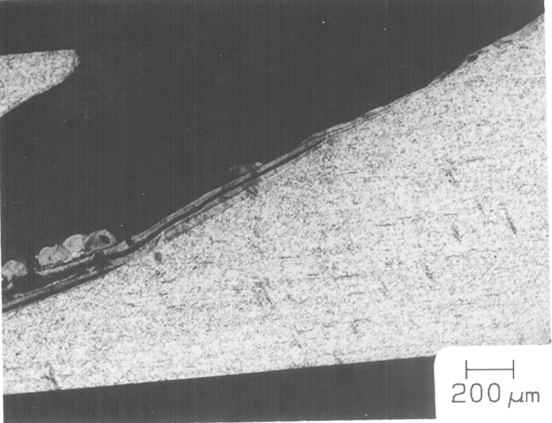
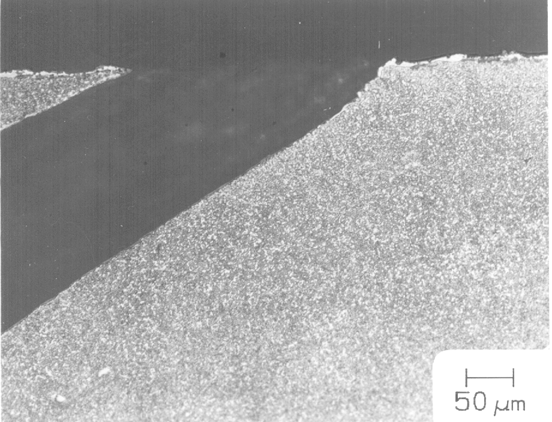
Figure 2. Cross sections of holes drilled in N5 superalloy by: the conventional laser with 0.6 ms pulse width, 8.5x106 W/cm2 intensity, and 1064 nm wavelength (left) ; and SHG of Q-switched MOPA laser at 300 ns pulse width, 7x108 W/cm2 intensity, and 532 nm wavelength (right). (X. Chen, 1999)
In the case of the conventional laser drilling, a recast layer is usually formed from the resolidified molten metal at the side walls. Typical average thickness of this layer is about 50 micron. Because of its rapid solidification, there are mircocracks formed in this recast layer that often extends into the parent material. These microcracks tend to reduce part life, and therefore recast layers are undesirable. Furthermore, the hole side walls are not straight, and the hole geometrical profiles varies significantly from hole to hole, because it takes just a few laser pulses of 1 - 10 J per pulse to drill a hole, thus render the process susceptible to variations in pulse energy and materials interactions.
In the case of the high intensity MOPA laser drilling, the recast layer is greatly reduced. Table 1 shows this trend clearly. This can be attributed to the two orders of magnitude higher intensity and the shorter wavelength at the shorter wavelength (SHG). At this high intensity, materials removal is achieved predominantly by vaporization, not melt expulsion, as in the case of conventional laser drilling. Energy coupling into the material is also believed higher at the shorter SHG wavelength. The side walls are also much straighter, and the hole to hole consistency higher, because this process relies on thousands of pulses with much smaller pulse energies (about 10 mJ).
Table 1. Average and Maximum Recast Layer Thickness Comparison for N5.
|
Average Recast Layer Thickness (mm) |
Maximum Recast Layer Thickness (mm) |
|
|
Percussion Drilling, 300 ns, 532 nm, 90° from surface |
5 |
15 |
|
Trepan Drilling, 300 ns, 532 nm, 90° from surface |
10 |
25 |
|
Trepan Drilling, 300 ns, 532 nm, 30° from surface |
2 |
10 |
|
Percussion Drilling, 1 ms, 1.064 mm, 30° from surface |
45 |
130 |
|
Percussion Drilling, 1 ms, 1.064 mm, 30° from surface |
80 |
200 |
Intermetallic materials are being considered for future high temperature applications for its lower weight advantage. However, they tend to be very brittle and thus difficult to machine, as evidenced by the bulk cracking demonstrated in Figure 3 (a). Therefore, the conventional long pulse, low intensity laser is not suitable for drilling of NiAl. Using the short pulse, high intensity MOPA at the 532 nm SHG wavelength, as shown in Figure 3 (b), can solve this problem.
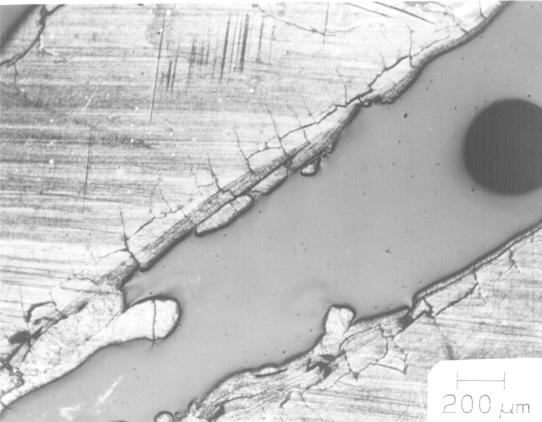
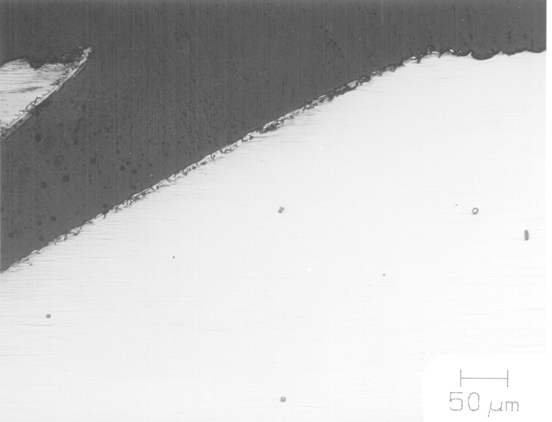
(a ) the conventional laser (b) SHG of Q-switched MOPA laser
Figure 3: Cross sections of holes drilled in NiAl intermetallic by: (a) the conventional laser with 0.6 ms pulse width, 8.5x106 W/cm2 intensity, and 1064 nm wavelength; and (b) SHG of Q-switched MOPA laser at 300 ns pulse width, 7x108 W/cm2 intensity, and 532 nm wavelength. (X. Chen, 1999)
Ceramics and Composites: Most composite materials present challenges to conventional machining processes because of a variety of reasons, such as extreme toughness, prone to delamination and charring. The non-contact nature of laser machining, combined with the gentle evaporative process, makes high brightness lasers suitable for these operations. X.L.Chen (1999) presented cutting and drilling results on metal matrix resin matrix, and ceramic matrix composites.
Laser cutting experiments were performed on 1mm thick plates of Al-30%SiC metal matrix composite samples, using the face-pumped slab laser. It was found that the cutting speed can be increased when the laser intensity is higher. At the same average laser power of 50 W, the maximum cutting speed improved from 2.0 inch/min. to 7.0 inch/min., when the intensity was increased from 4x105 W/cm2 to 6x106 W/cm2 by shortening the pulse width from 9.4 ms to 0.65 ms. At the higher intensity, cut quality was also greatly improved.
Hole drilling tests were done on all three composite materials. Both free-running the face-pumped slab laser and the Q-switched or modelocked/Q-switched MOPA laser were used to provide a wide intensity range of 105 to 108 W/cm2. The second harmonic wavelength of 532 nm was also used in the MOPA laser. In the slab laser experiments, percussion drilling was used, while in the MOPA laser drilling, trepanning technique was employed to cut a 0.5 mm diameter hole in the 1 mm thick Al-30%SiC sample. Again, the average power of the lasers were kept at 50 W for comparison study.
Figure 4 shows the depths of heat affect zone at the different intensity levels and the two wavelengths. It was evident that the increased intensity improved the hole quality, but the shortened laser wavelength was the reason for the still more significant improvements. The more efficient energy coupling into the material at the shorter wavelength is credited for this phenomenon.
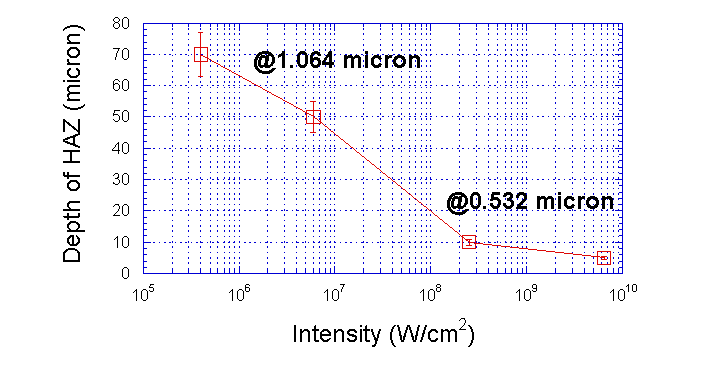
Figure 4. Depth of heat affected zone (HAZ), including the recast layer, in drilled samples of Al-30%SiC is greatly reduced when the higher intensity is achieved at higher intensity and shorter wavelength. Average power is kept at 50 W. (X. Chen, 1999)
In hole drilling of the resin matrix composite (RMC), 6.4 mm diameter holes were trepanned in 5 mm thick samples. The MOPA laser operating at Q-switched mode was employed at 50 W average power at 532 nm wavelength. A cross section of the hole side-walls is presented in Figure 5. Excellent edge quality was achieved, with no charring, delamination, or heat affected zones observable.
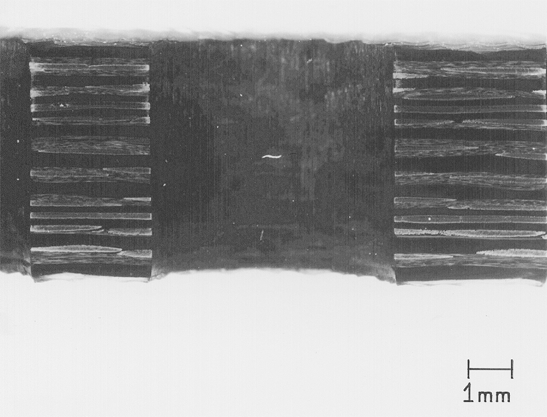
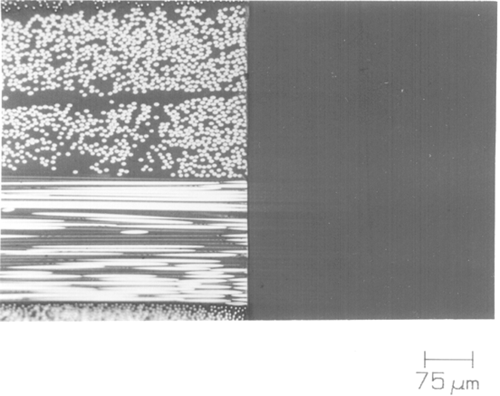
Figure 5. Cross sections of trepan drilled holes in resin matrix composite by Q-switched Nd:YAG MOPA laser at the second harmonic wavelength of 532 nm. left: Entire hole; right: Detail. (X. Chen, 1999)
Material Removal Rate: X.L. Cheng (1999) showed that regardless of pulse energy, a nice straight line can be plotted in the log-log scale, meaning that a power law exists between the volume of material removed and the total laser energy irradiated. It is observed that, for the same total irradiated laser energy, femtosecond pulses remove 2-3 times more material than the nanosecond pulses. However, even the state-of-the-art CPA laser system can only deliver 1-10 W of average power, while nanosecond lasers of hundreds of watts average power are readily available. Therefore, current CPA femtosecond lasers are still too small in average power to deliver any meaningful process speeds. For example, it takes a 1 W ultrafast laser more than a minute to drill a 1 mm deep hole of 0.1 mm diameter.
It was concluded that using Nd:YAG lasers and a Ti:sapphire ultrafast laser, with wide ranges of parameters, maximum machining speed and surface quality are improved with higher laser intensity. The use of the shorter second harmonic wavelength further reduced the thermal and mechanical damages to the parent materials significantly. The enhanced energy coupling and vaporization were thought to be the reasons for the improvements.
Short pulse lasers such as copper vapour lasers (CVL) have shown a potential in achieving precision machining due to its high pulse power, high repetition rate, and good focusability. Bergmann, H.W. et. al., considered scientific and industrial aspects of drilling and cutting with CVL and compare them with earlier results presented using other lasers. The influence of a laser surface treatment via short ultraviolet pulses on the electro-chemical and corrosion characteristics of stainless steel and aluminum alloys was investigated. By choosing the laser parameters appropriately, a significant improvement in the corrosion behavior of the components can be achieved; the laser treatment was successfully applied to protect susceptible surface areas locally
Laser ablation is extremely well suited for rapid prototyping and proves to be a versatile technique delivering high accuracy dimensioning and repeatability of features in a wide diversity of materials. Naessens, Kris, et. al., (2000) presented laser ablation as a fabrication method for micro machining of arrays consisting of precisely dimensioned U-grooves in dedicated polycarbonate and polymethylmetacrylate plates. The dependency of the performance on various parameters (wavelength, energy density and pulse frequency) is discussed. The fabricated plates are used to hold optical fibres by means of a UV-curable adhesive. Stacking and glueing of the plates allows the assembly of a 2D connector of plastic optical fibres for short distance optical interconnects.